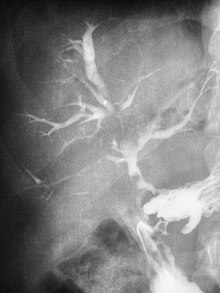| Biliary fistula | |
|---|---|
 | |
| Duodeno Biliary Fistula | |
| Specialty | General surgery |
A biliary fistula is a type of fistula in which bile flows along an abnormal connection from the bile ducts into a nearby hollow structure. Types of biliary fistula include:
- bilioenteric fistula: abnormal connection to small bowel, usually duodenum.
- thoracobiliary fistula: abnormal connection to pleural space or bronchus (rare).
- bronchobiliary fistula: pathological communication between a bronchus and the biliary tract (extremely rare).[1]
These may be contrasted to a bile leak, in which bile escapes the bile ducts through a perforation or faulty surgical anastomosis into the abdominal cavity. Damage to a bile duct may result in a leak, which may eventually become a biliary fistula.
- ^ Shahzad, Salman; Younus, Tahira; Khan, Eitzaz Ud Din (June 2, 2021). "Anesthetic management for endoscopic retrograde cholangiopancreatography in bronchobiliary fistula: a case report". Anaesthesia, Pain & Intensive Care. 25 (3): 399–401–399–401. doi:10.35975/apic.v25i3.1517 (inactive 2024-09-12) – via www.apicareonline.com.
{{cite journal}}: CS1 maint: DOI inactive as of September 2024 (link)